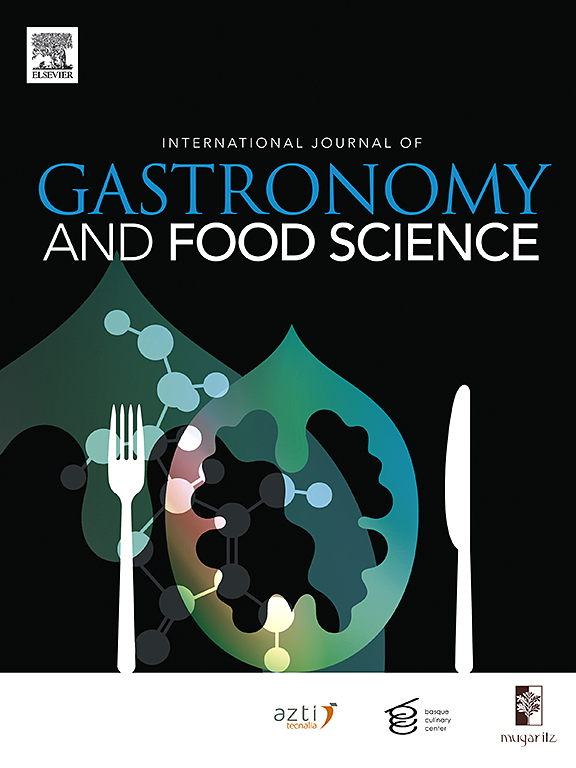Raw materials and manufacturing environment as determinants of miso bacterial community
IF 3.6
2区 农林科学
Q2 FOOD SCIENCE & TECHNOLOGY
International Journal of Gastronomy and Food Science
Pub Date : 2025-06-07
DOI:10.1016/j.ijgfs.2025.101222
引用次数: 0
Abstract
Miso is a Japanese traditional fermented food with soybeans, salt and koji, and has gained attention among people for its sophisticated flavor and preservability. Koshu miso is a unique miso made by mixing two types of koji (rice and barley), and is produced primarily in Yamanashi Prefecture, Japan. We characterized the microbiota of Koshu miso at three distinct fermentation stages. Our analysis revealed that the genus Staphylococcus dominated across all miso samples. Notably, Staphylococcus sequences in the miso matched those found in rice and barley koji, indicating the influence of raw ingredients on the initial bacterial community. Additionally, analysis of the manufacturing environment suggested similarities between the environmental surfaces and miso, highlighting the importance of the manufacturing environment in serving as a medium for bacterial transfer. These findings underscore the critical importance of both raw ingredients and manufacturing equipment in shaping the bacterial composition and evolution of miso throughout the fermentation process.

原料和生产环境是味噌菌群的决定因素
味噌是一种日本传统的以大豆、盐和曲为原料的发酵食品,因其精致的风味和保鲜性而受到人们的关注。歌州味噌是一种独特的味噌,由两种曲(大米和大麦)混合而成,主要产于日本山梨县。我们在三个不同的发酵阶段对古曲味噌的微生物群进行了表征。我们的分析显示葡萄球菌属在所有味噌样品中占主导地位。值得注意的是,味噌中的葡萄球菌序列与大米和大麦曲中的葡萄球菌序列相匹配,这表明原料对初始细菌群落的影响。此外,对生产环境的分析表明,环境表面和味噌之间存在相似性,强调了生产环境作为细菌转移媒介的重要性。这些发现强调了原料和制造设备在整个发酵过程中形成味噌细菌组成和进化的关键重要性。
本文章由计算机程序翻译,如有差异,请以英文原文为准。
求助全文
约1分钟内获得全文
求助全文
来源期刊

International Journal of Gastronomy and Food Science
Social Sciences-Cultural Studies
CiteScore
5.30
自引率
10.50%
发文量
170
审稿时长
45 days
期刊介绍:
International Journal of Gastronomy and Food Science is a peer-reviewed journal that explicitly focuses on the interface of food science and gastronomy. Articles focusing only on food science will not be considered. This journal equally encourages both scientists and chefs to publish original scientific papers, review articles and original culinary works. We seek articles with clear evidence of this interaction. From a scientific perspective, this publication aims to become the home for research from the whole community of food science and gastronomy.
IJGFS explores all aspects related to the growing field of the interaction of gastronomy and food science, in areas such as food chemistry, food technology and culinary techniques, food microbiology, genetics, sensory science, neuroscience, psychology, culinary concepts, culinary trends, and gastronomic experience (all the elements that contribute to the appreciation and enjoyment of the meal. Also relevant is research on science-based educational programs in gastronomy, anthropology, gastronomic history and food sociology. All these areas of knowledge are crucial to gastronomy, as they contribute to a better understanding of this broad term and its practical implications for science and society.
 求助内容:
求助内容: 应助结果提醒方式:
应助结果提醒方式:


